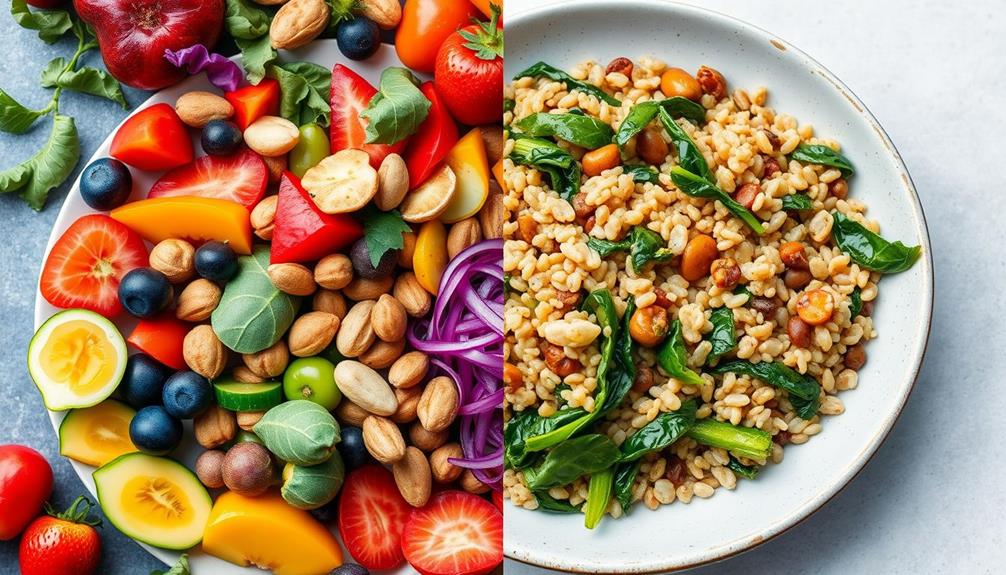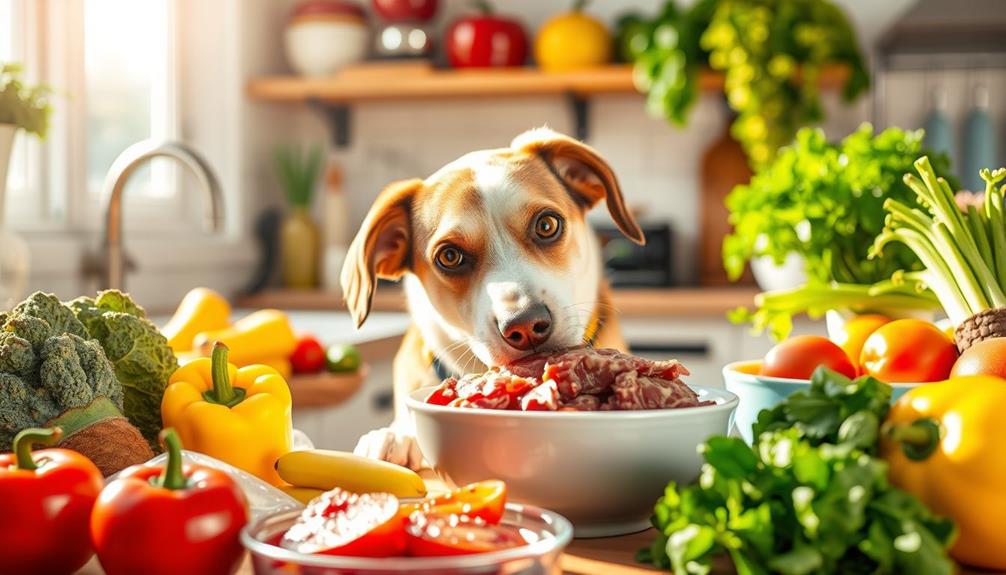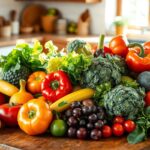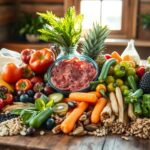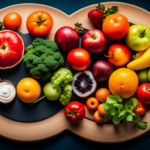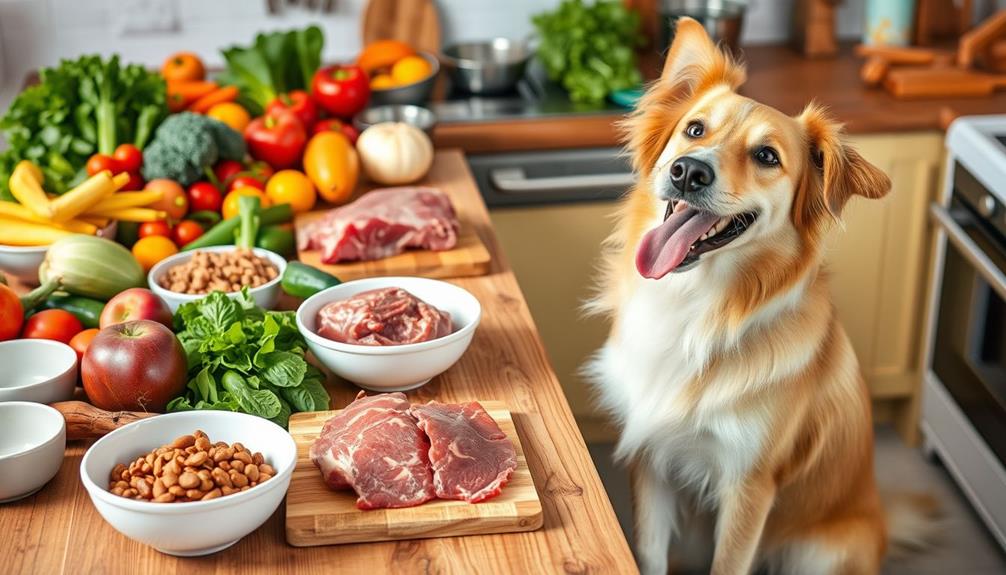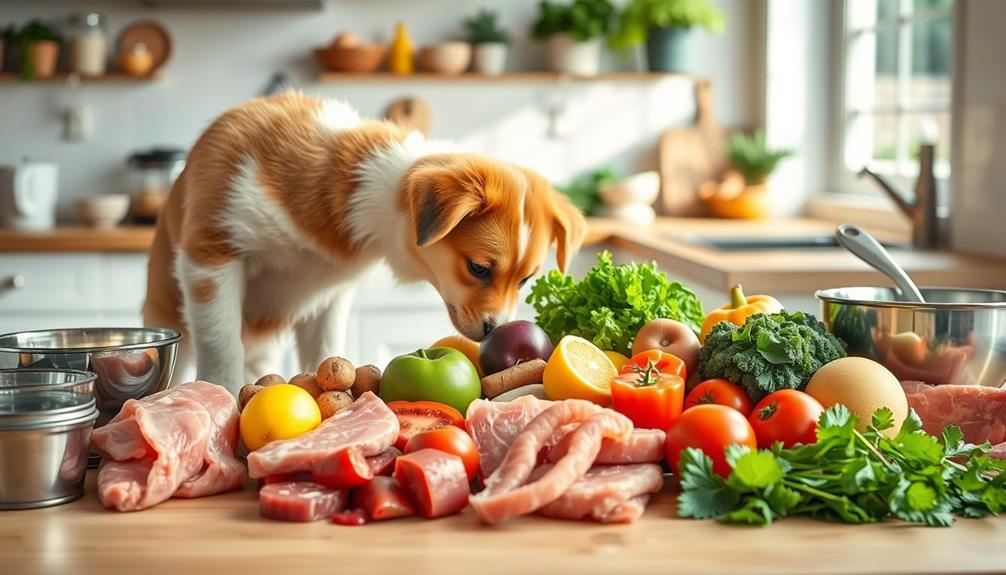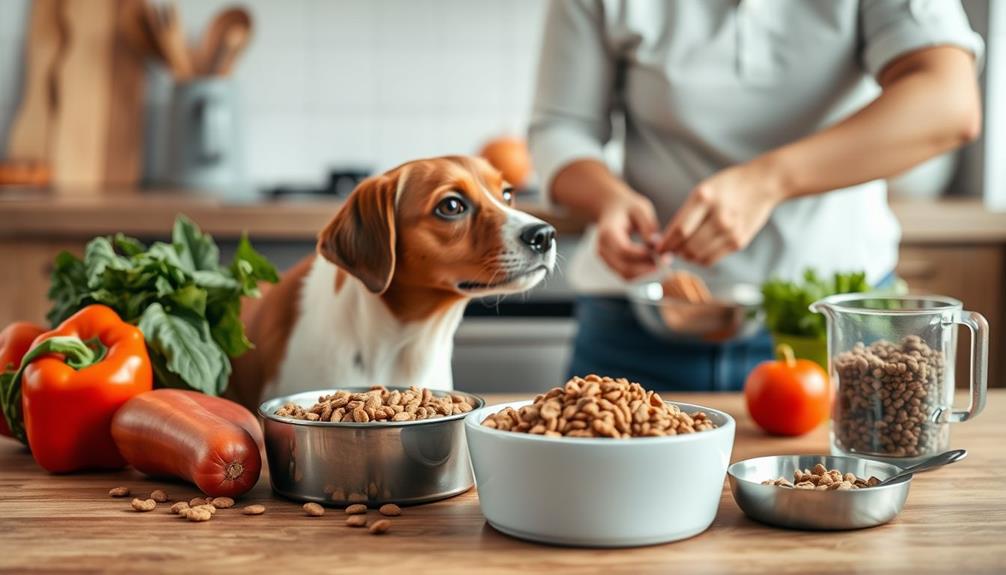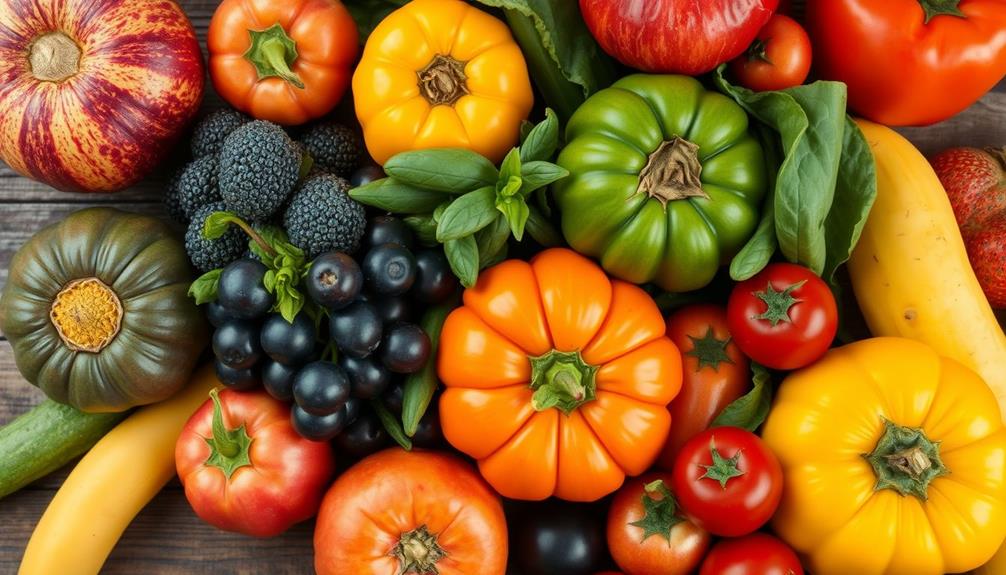When you compare raw food and vegan diets, both have distinct advantages and challenges. A vegan diet includes all plant-based foods but may require careful planning to avoid vitamin and mineral deficiencies. In contrast, a raw vegan diet emphasizes unprocessed foods, which some believe retain more nutrients. However, it can also lead to nutritional gaps, especially in vitamins like B12 and calcium. Both diets can support heart health and weight management, but it's crucial to guarantee adequate nutrient intake. Discover more about how to balance these diets effectively to maximize their benefits. One way to address potential nutrient deficiencies in a raw vegan diet is to incorporate supplements or fortified foods. Additionally, understanding the principles of food combining and incorporating a variety of fruits, vegetables, nuts, and seeds can help ensure a well-rounded nutrient intake. The raw food diet explained emphasizes consuming foods in their natural state, which can provide enzymes and antioxidants that may be lost during cooking or processing. Finding a balance between raw and cooked foods may also provide a more sustainable approach to long-term health and nutrition.
Key Takeaways
- A vegan diet includes cooked plant-based foods, while a raw vegan diet focuses on raw or minimally heated foods for at least 75% of intake.
- Veganism offers more flexibility in food choices, potentially enhancing nutritional balance and reducing risk of deficiencies.
- Raw vegan diets may promote weight loss due to low caloric density but require careful planning to prevent nutrient deficiencies.
- Cooking can enhance nutrient bioavailability, making certain vitamins and minerals more accessible compared to raw food consumption.
- Both diets can lower chronic disease risks, but vegan diets may provide better overall nutritional adequacy when properly managed.
Overview of Vegan Diet
A vegan diet strictly excludes all animal products, meaning you won't consume meat, fish, dairy, eggs, or even honey. Instead, this diet includes a variety of plant-based foods such as fruits, vegetables, grains, nuts, and seeds.
One of the significant health benefits of eating a vegan diet is its association with lower risks of chronic diseases, including certain cancers, heart disease, and type II diabetes. Additionally, the focus on whole foods can enhance your intake of antioxidants, promoting overall health and well-being, as seen in the benefits of celery juice.
By focusing on nutrient-dense foods, you're likely to maintain lower cholesterol levels and body mass indexes (BMI), which can lead to improved digestion and potential weight loss.
The diverse range of plant-based foods offers many nutrients humans need, but proper planning is essential to avoid deficiencies. Pay particular attention to vitamin B12, iron, calcium, and omega-3 fatty acids, as these are vital for your overall health.
While you might be tempted to indulge in processed foods, it's best to prioritize whole foods to reap the full benefits of a vegan lifestyle.
Overview of Raw Vegan Diet
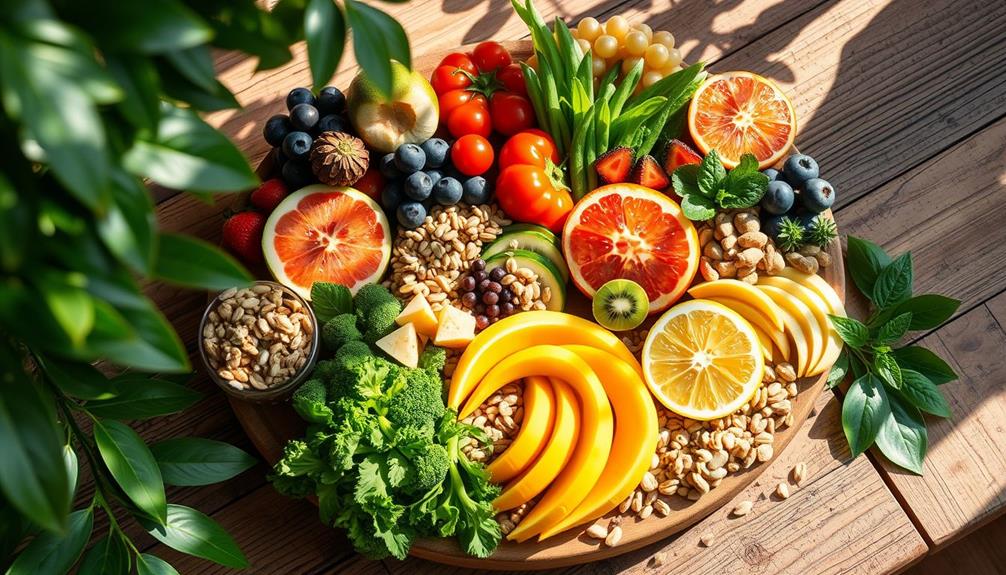
Raw vegan diets take the principles of veganism a step further by requiring that at least 75% of your food intake comes from raw or minimally heated sources. This means you'll exclude all animal products and focus primarily on unprocessed foods like fruits, vegetables, nuts, seeds, and sprouted grains.
Advocates believe that cooking food diminishes nutrients, making raw foods more healthful. Additionally, incorporating a variety of essential oils for health can support your overall well-being while following this diet.
Nutritional planning is vital in a raw vegan diet to prevent nutrient deficiencies, particularly in essential vitamins and minerals like vitamin B12, calcium, and vitamin D. Failing to plan your meals carefully can lead to health issues over time.
While a raw vegan diet may offer health benefits, such as improved heart health and lower body fat percentages, it requires a balanced approach. You should be mindful, as there are potential adverse effects, including menstrual irregularities in women.
Health Benefits of Veganism
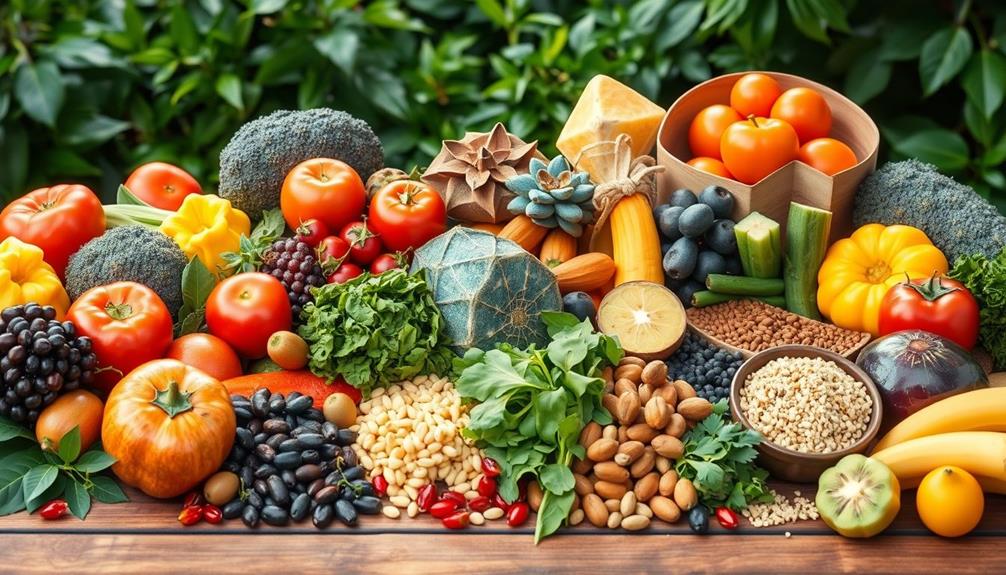
Embracing a vegan diet can lead to numerous health benefits that positively impact your overall well-being. By focusing on plant-based diets, you'll likely reduce your risk of specific cancers, heart disease, and type II diabetes. The emphasis on whole foods that are high in dietary fiber and low in saturated fats contributes markedly to these outcomes.
Additionally, adopting a vegan lifestyle may align with natural remedies alongside conventional medications, promoting a holistic approach to health.
You may notice improvements in your cholesterol levels and body mass index (BMI). Research indicates that vegans typically exhibit lower cholesterol levels, which enhances heart health and aids in effective weight management. In fact, studies show that individuals on a vegan regimen can lose 22-26 pounds over 3.5 years.
A vegan diet also helps improve digestion and gut health due to the high intake of dietary fiber from fruits, vegetables, and legumes.
Not to mention, the nutritional benefits are substantial; you'll get higher levels of essential vitamins and minerals, such as vitamin C and magnesium, found abundantly in plant foods. These nutrients play essential roles in various bodily functions, making a vegan lifestyle a path toward better health.
Health Benefits of Raw Veganism
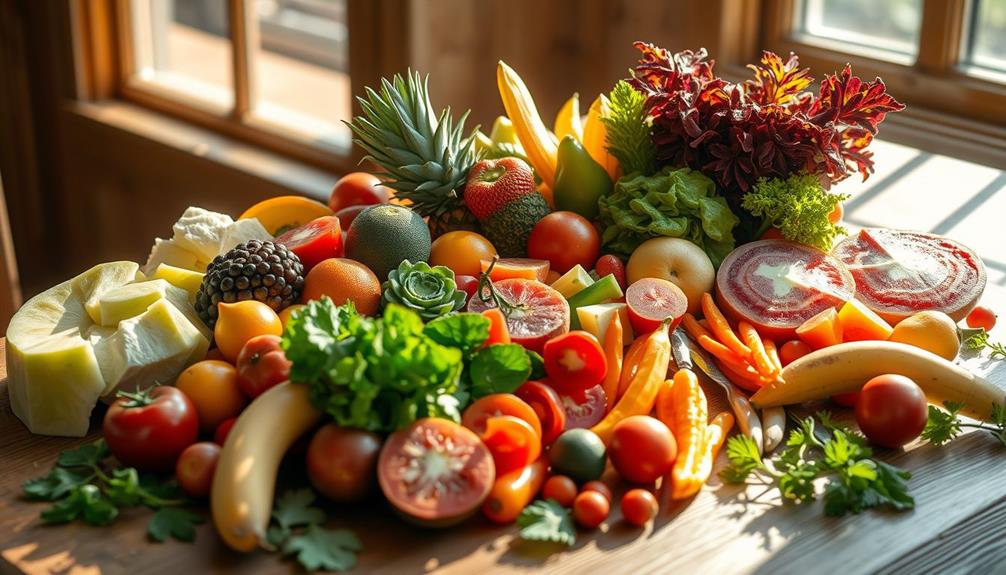
The raw vegan lifestyle offers a unique blend of health benefits that can greatly enhance your well-being. By focusing on nutrient-dense plant foods, you can markedly improve your heart health, lower blood pressure, and reduce the risk of heart disease.
Incorporating a balanced diet rich in fruits and vegetables is essential for overall health, as it not only provides necessary vitamins and minerals but also supports kidney health by promoting hydration and reducing sodium intake effective strategies for weight loss. The high fiber content in raw veganism not only aids digestion but also supports blood sugar control, potentially lowering your risk of type 2 diabetes by 12%.
If you're looking to lose weight, this diet might be beneficial for you as participants have reported an average weight loss of 22-26 pounds over 3.5 years. This weight loss often leads to lower body fat percentages, which can positively impact overall health.
Additionally, consuming raw foods helps preserve necessary nutrients and enzymes that cooking can diminish, enhancing nutrient retention in your diet.
However, it's important to engage in careful planning to avoid deficiencies in essential nutrients like vitamin B12, calcium, and vitamin D. Prioritizing these necessary nutrients will guarantee that you reap the full benefits of raw veganism while maintaining peak health.
Nutritional Risks of Veganism
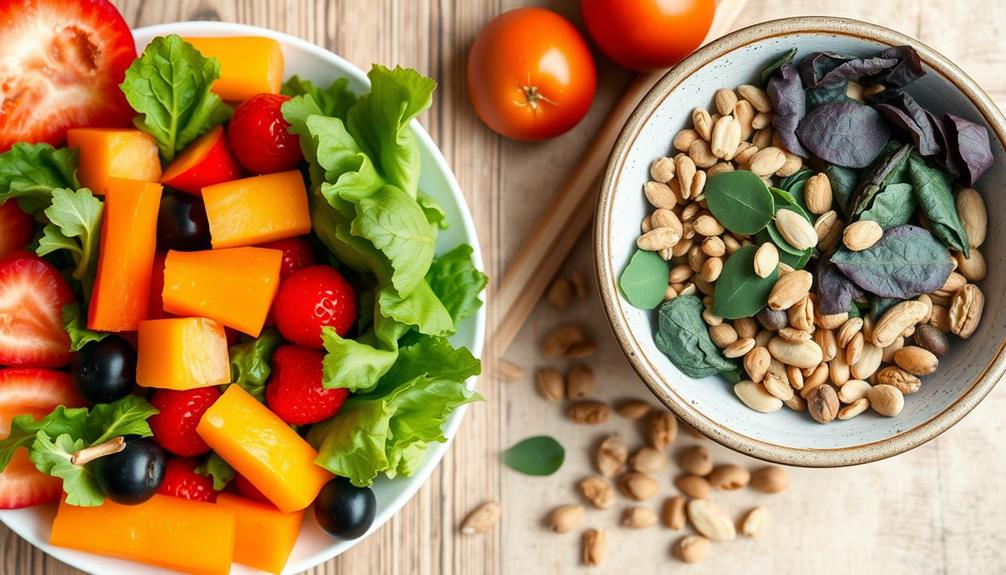
While exploring the health benefits of a raw vegan diet, it's important to recognize that poorly planned veganism can lead to significant nutritional risks. One of the most critical concerns is vitamin B12 deficiency, which can cause anemia and neurological issues.
Without animal products in your diet, you'll need to rely on fortified foods or supplements to meet your B12 requirements. Additionally, understanding your financial goals can help you allocate resources for purchasing high-quality supplements and fortified foods that support a balanced vegan diet.
Iron is another area where you might face challenges. The non-heme iron found in plant sources isn't absorbed as efficiently as the heme iron in animal products, increasing your risk of iron deficiency anemia.
Similarly, calcium intake may be inadequate on a vegan diet, affecting your bone health. Since dairy is a primary calcium source for many, you'll want to explore alternatives like fortified plant milks or leafy greens.
Lastly, omega-3 fatty acids are essential for heart and brain health but are mainly found in fish. To guarantee you're getting enough, consider incorporating algae-based supplements or flaxseeds into your meals.
Nutritional Risks of Raw Veganism
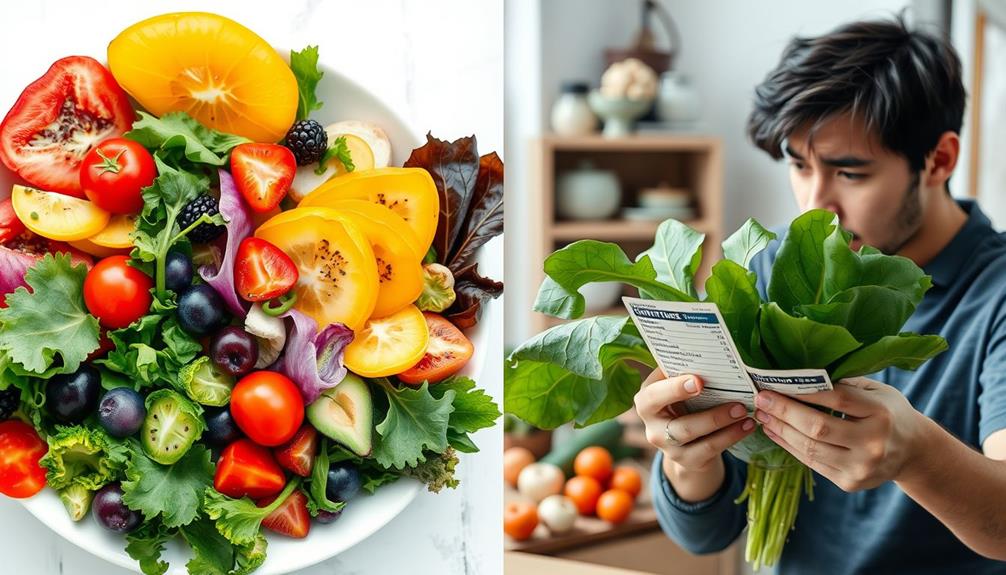
Following a raw vegan diet can lead to several nutritional risks that you should be aware of. One significant concern is the potential for nutritional deficiencies, especially in essential vitamins like B12, calcium, and vitamin D, primarily due to the complete exclusion of animal products.
This diet can also result in insufficient protein intake, which may lead to muscle weakness and increased tooth decay from the acidity of raw fruits. Additionally, the key domains of development in psychology emphasize the importance of balanced nutrition for healthy growth and emotional well-being.
Moreover, many women on raw vegan diets experience menstrual irregularities, with about 33% reporting amenorrhea, often linked to low caloric intake and nutrient deficiencies. The absence of cooked foods can also limit nutrient absorption; for instance, iron and calcium are better absorbed when foods are cooked.
Additionally, consuming raw foods increases the risk of foodborne illnesses, highlighting the importance of proper washing and handling of produce.
Weight Management Considerations
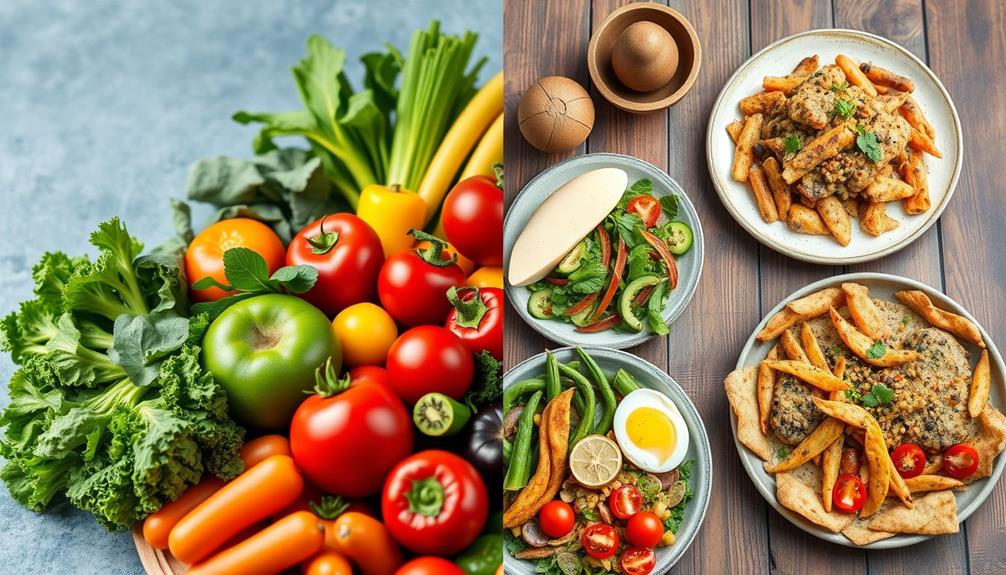
When considering weight management on a raw vegan diet, you'll find that its high fiber content can greatly support your efforts. This diet requires a focus on whole, plant-based foods, which can help lower body fat percentages.
Many participants have reported losing an average of 22-26 pounds over about 3.5 years, largely due to increased satiety from fiber-rich foods. Additionally, incorporating a variety of numerous coffee varieties can provide unique flavors and aromas that enhance your dining experience.
However, it's vital to maintain adequate caloric intake to prevent issues like menstrual irregularities, with around 70% of women on this diet experiencing such complications.
While the raw vegan diet can promote weight loss, careful planning is key to guarantee nutritional balance. Insufficient caloric intake can lead to low energy levels and nutrient deficiencies, complicating your weight management efforts.
You'll need to be mindful of incorporating a variety of foods to meet your body's needs.
Ultimately, while a raw vegan diet can be effective for weight management, it's important to prioritize adequate nutrients and manage your caloric intake. This way, you can enjoy the benefits of this lifestyle without compromising your overall health.
Cooking and Nutrient Absorption
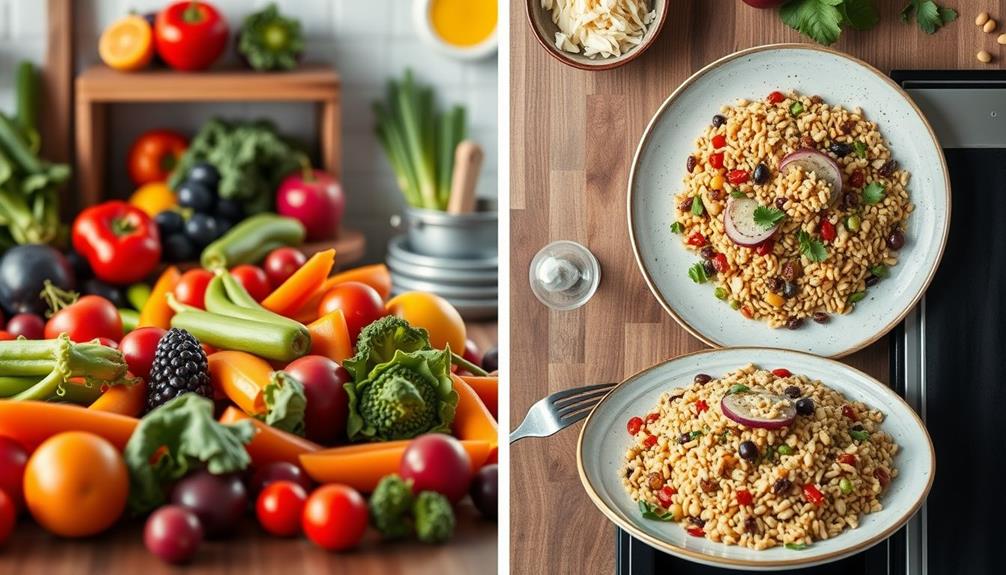
Cooking plays an essential role in nutrient absorption, as it can greatly enhance the bioavailability of certain nutrients. For instance, cooking tomatoes considerably increases the levels of lycopene, a powerful antioxidant, by five-fold.
While raw food diets emphasize uncooked fruits and vegetables, cooking helps break down fibrous cell walls, allowing for better absorption of vital minerals like iron and calcium, which can be less accessible in raw foods. In addition, incorporating ingredients like butter in cooked dishes can also enhance flavor and nutrient absorption, as butter is a source of vitamins A, D, E, and K.
Although some argue that cooking diminishes enzymes, your body produces its own digestive enzymes, making the impact of raw food enzymes negligible. Moreover, the acidic environment of your stomach inactivates raw enzymes before they can aid in digestion. This raises questions about the benefits of consuming raw foods for digestive health.
Furthermore, a diet focused solely on raw foods may lead to insufficient energy levels. High-fat raw foods can lead to excessive caloric intake, while relying on fruits alone mightn't provide enough calories for your daily activities.
In contrast, cooking offers a way to boost nutrient absorption while ensuring you get the necessary energy levels from a balanced diet.
Common Misconceptions
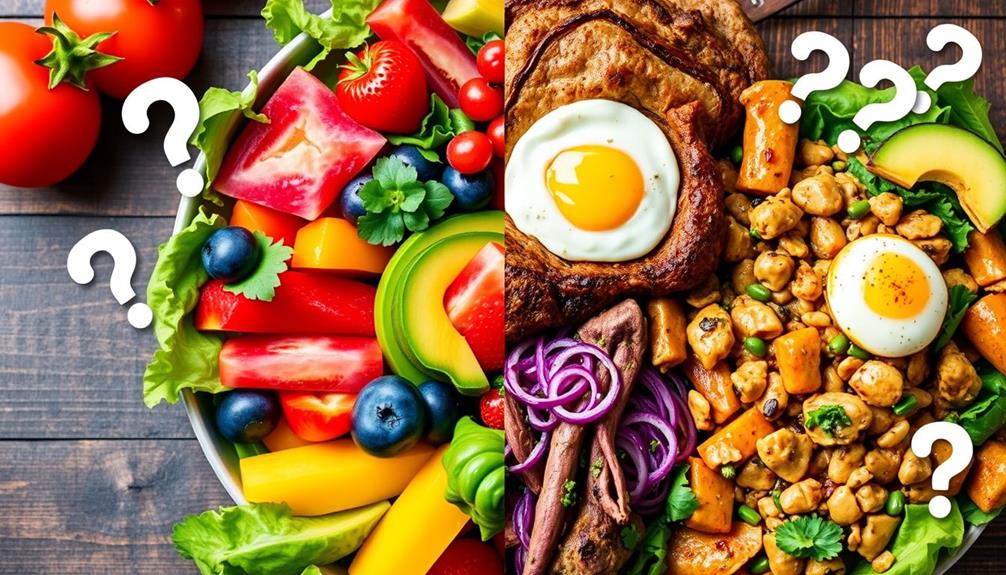
Misconceptions about raw food and vegan diets abound, often leading to confusion about their health benefits. Many people think that a raw vegan diet guarantees superior nutrient retention, but cooking can actually enhance the bioavailability of certain nutrients. For example, lycopene in tomatoes increases five-fold when cooked.
Additionally, different cooking methods, such as those used in coffee brewing, can affect the nutritional content of foods and beverages, highlighting the significance of preparation techniques various brewing methods. There's also a belief that raw food enzymes aid digestion, but the acidic environment of your stomach deactivates them before they can be useful.
Another common myth is that all animal products are harmful. This overlooks the essential benefits of certain animal-derived foods, particularly vitamin B12, vital for nerve function and absent in raw vegan diets. While a raw vegan lifestyle may seem risk-free, it can lead to nutritional deficiencies in vitamin B12, calcium, and protein without careful planning, potentially causing serious health issues.
Additionally, many assume cooking destroys all nutrients, but this isn't true. Cooking can break down plant cell walls, making nutrients more accessible and improving mineral absorption from plant foods.
Understanding these misconceptions can help you make more informed dietary choices.
Tips for a Balanced Diet
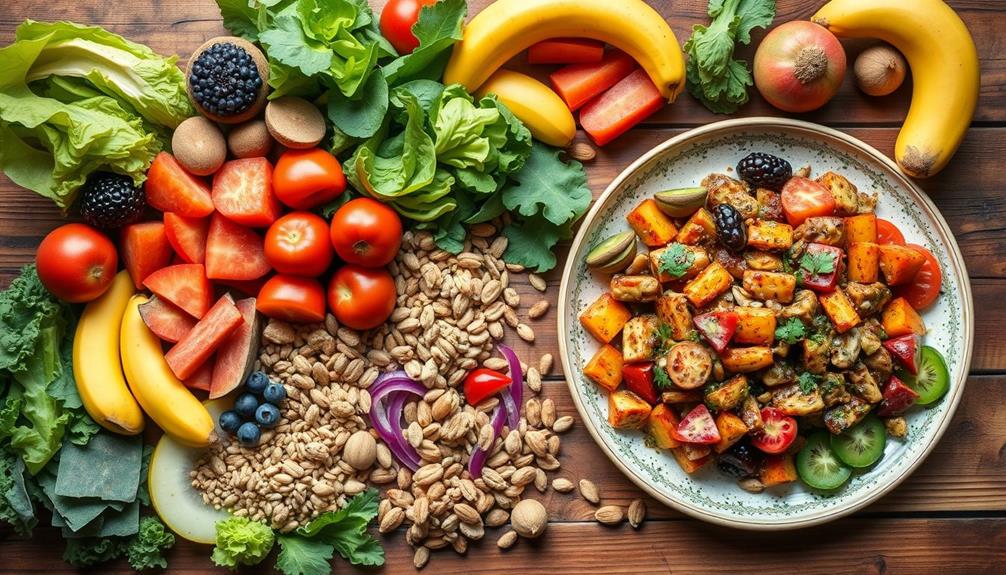
How can you maintain a balanced diet while following a raw vegan lifestyle? Start by ensuring that at least 75% of your food intake consists of raw foods like fruits and vegetables, nuts, and seeds. This variety helps meet your nutrient needs while steering clear of processed items that often lack essential nutrients.
Incorporate nutrient-dense foods such as leafy greens and sprouted legumes to prevent deficiencies in protein, calcium, and vitamin B12. A raw food diet can also boost immune system function by providing high levels of vitamins and antioxidants, further supporting your overall health.
To address potential deficiencies from a strict raw vegan diet, consider supplementing with vitamin B12, vitamin D, and omega-3 fatty acids. These supplements can help you maintain your overall health.
Additionally, regularly include foods rich in healthy fats, like avocados and nuts, to enhance satiety and support your energy needs while balancing macronutrient intake.
Lastly, prioritize food safety by washing your produce thoroughly to minimize the risk of foodborne illnesses associated with consuming raw foods. By following these tips, you can create a balanced diet that supports your raw vegan lifestyle while ensuring you meet your nutritional needs.
Frequently Asked Questions
Which Is Better, Raw Vegan or Vegan?
When deciding between raw vegan and vegan diets, consider your lifestyle and nutritional needs. Raw veganism offers unique benefits but can be restrictive. A vegan diet provides more variety, making it easier to maintain and enjoy.
Is Raw Diet the Healthiest?
Imagine a garden flourishing under the sun. A raw diet's vibrant, fresh offerings can boost your health, but without balance, you might find yourself wilting, lacking essential nutrients. It's not the only path to wellness.
Are Vegans Healthier Then Meat Eaters?
You'll find that many studies suggest vegans generally have lower BMIs, cholesterol levels, and chronic disease risks compared to meat eaters. Their diet often leads to better digestive health and overall well-being, too.
Is Vegan Really the Healthiest Diet?
Imagine vibrant fruits and vegetables painting your plate. A vegan diet can be incredibly healthy, provided you choose whole foods wisely. It offers benefits like lower cholesterol and better digestion, but balance is key to avoid deficiencies.
Conclusion
In the debate between raw food and vegan diets, it really boils down to what works best for you. Both have their perks and potential pitfalls, so finding balance is key. Remember, "you are what you eat," so choose foods that nourish your body and fit your lifestyle. Whether you opt for a vibrant array of cooked veggies or stick to raw delights, focus on variety and moderation for a healthier you.

